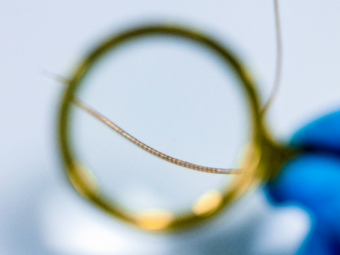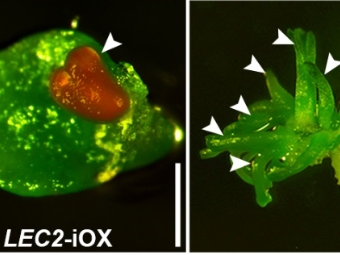|
|
|
|
|
ж•ҷдҪ еҰӮдҪ•иҜҶеҲ«вҖңжҺ еӨәжҖ§вҖқжңҹеҲҠ | BMC Medicine |
|
|
и®әж–Үж ҮйўҳпјҡPotential predatory and legitimate biomedical journals: can you tell the difference? A cross-sectional comparison
жңҹеҲҠпјҡBMC Medicine
дҪңиҖ…пјҡLarissa Shamseer, David Moher, Onyi Maduekwe, Lucy Turner, Virginia Barbour, Rebecca Burch, Jocalyn Clark, James Galipeau, Jason Roberts and Beverley J. Shea
еҸ‘иЎЁж—¶й—ҙпјҡ2018/03/16
ж•°еӯ—иҜҶеҲ«з Ғпјҡ10.1186/s12916-017-0785-9
еҺҹж–Үй“ҫжҺҘпјҡhttps://bmcmedicine.biomedcentral.com/articles/10.1186/s12916-017-0785-9?utm_source=WeChat&utm_medium=Website_linksSocial_media_organic&utm_content=CelZha-MixedBrand-multijournal-Multidisciplinary-China&utm_campaign=ORG_AWA_CZH_BMCWechat_dailyposts_blogs
еҫ®дҝЎй“ҫжҺҘпјҡhttps://mp.weixin.qq.com/s/xt6Z4JreFTq4bgvrBSvyew
дёҖзҜҮеңЁBMC MedicineдёӯеҸ‘иЎЁзҡ„ж–°з ”з©¶ж—ЁеңЁзЎ®е®ҡжҪңеңЁ“жҺ еӨәжҖ§”жңҹеҲҠзҡ„зү№еҫҒпјҡ收еҸ–еҮәзүҲиҙ№иҖҢдёҚжҸҗдҫӣзј–иҫ‘жңҚеҠЎжҲ–жӯЈи§„еҗҢиЎҢиҜ„е®Ўзҡ„еңЁзәҝжңҹеҲҠгҖӮиҜҘз ”з©¶зҡ„дёӨдҪҚдҪңиҖ…David Moherе’ҢLarissa ShamseerеңЁжӯӨеҗ‘жҲ‘们д»Ӣз»ҚдәҶ他们зҡ„е·ҘдҪңеҸҠе…¶еҰӮдҪ•иғҪеӨҹеё®еҠ©дҪңиҖ…гҖӮ
й»‘еҗҚеҚ•
зҠҜзҪӘж•…дәӢйҖҡеёёиў«жҸҸз»ҳдёәе–„дёҺжҒ¶д№Ӣй—ҙзҡ„ж–—дәүгҖӮеҸ‘иЎЁз”ҹзү©еҢ»еӯҰз ”з©¶д№ҹзұ»дјјдәҺжӯӨгҖӮеҮ е№ҙеүҚпјҲзҺ°е·ІеҒңжӯўпјү“еӯҰжңҜејҖж”ҫиҺ·еҸ–пјҲScholarly Open Accessпјү”зҪ‘з«ҷеҲ—еҮәдәҶиў«и§ҶдёәеҠЈиҙЁзҡ„жңҹеҲҠе’ҢеҮәзүҲе•ҶпјҢеҚідёҖд»Ҫ“й»‘еҗҚеҚ•”гҖӮ
дёәдәҶеҫ—еҲ°й»‘еҗҚеҚ•пјҢе…¶зӯӣйҖүж•ҙзҗҶдәәе‘ҳJeffrey BeallйҮҮз”ЁдәҶжқҘиҮӘеҮәзүҲйҒ“еҫ·е§”е‘ҳдјҡпјҲCommittee on Publication Ethicsпјүе’ҢејҖж”ҫиҺ·еҸ–еӯҰжңҜеҮәзүҲе•ҶеҚҸдјҡпјҲOpen Access Scholarly Publisher’s Associationпјүзҡ„и®ёеӨҡж ҮеҮҶпјҢиҜёеҰӮжңҹеҲҠзҪ‘з«ҷдёҠиғҪеӨҹеҫҲе®№жҳ“иҫЁиҜҶзҡ„з»јеҗҲдҪңиҖ…жҢҮеҚ—гҖӮеҰӮжһңд»–и®ӨдёәжңҹеҲҠе’Ң/жҲ–еҮәзүҲе•ҶдёҚз¬ҰеҗҲиҝҷдәӣж ҮеҮҶпјҢеҲҷе°Ҷе…¶ж·»еҠ еҲ°д»–зҡ„еҲ—иЎЁдёӯгҖӮд»–еҲӣйҖ дәҶ“жҺ еӨәжҖ§”жңҹеҲҠе’ҢеҮәзүҲе•ҶиҝҷдёҖжңҜиҜӯз”ЁжқҘжҸҸиҝ°иҝҷдәӣе®һдҪ“гҖӮ
жҲ‘们еҖҫеҗ‘е°Ҷ他们жҸҸиҝ°дёәйқһжі•е®һдҪ“пјҲеҚіжңӘз»Ҹжі•еҫӢи®ёеҸҜе’Ң/жҲ–дёҚз¬ҰеҗҲе…¬и®Өж ҮеҮҶжҲ–и§„з« пјүпјӣжҲ‘们жңүж„ҸйҒҝе…ҚдҪҝз”Ёдё»йўҳиҜҚ“жңҹеҲҠ”гҖӮиҝҷжҳҜдёҖдёӘеҲәиҖідҪҶжҲ‘们и®ӨдёәеҸҲжңүеҝ…иҰҒзҡ„жңҜиҜӯпјҢеӣ дёәж №жҚ®жҲ‘们д»ҠеӨ©еҸ‘иЎЁдәҺBMC Medicineзҡ„з ”з©¶з»“жһңпјҢ他们зҡ„иҝҗдҪңдјјд№ҺдёҺеҗҲжі•еҸҜдҝЎзҡ„жңҹеҲҠжүҖйҒөеҫӘзҡ„ж ҮеҮҶе®Ңе…ЁиғҢзҰ»гҖӮ
иҝҷдәӣйқһжі•е®һдҪ“е®Јз§°иҮӘе·ұйҒөеҫӘжңҖдҪіе®һи·өеҮәзүҲж ҮеҮҶгҖӮдҪҶжҳҜ他们似д№Һ规йҒҝдәҶдёҖеҲҮ科еӯҰиҰҒжұӮпјҢд»Һжү§иЎҢеҗҢиЎҢиҜ„е®ЎеҲ°еҶ…е®№зҡ„ж•°еӯ—еҢ–еңЁзәҝеӣһжәҜпјҲMedlineзҙўеј•жңҹеҲҠиҰҒжұӮпјүгҖӮ
жҺ еӨәжҖ§йӮҖиҜ·
е°Ҫз®Ўй»‘еҗҚеҚ•е…·жңүиӢҘе№ІйҷҗеҲ¶пјҢеҢ…жӢ¬з”ЁжқҘиҫЁиҜҶжңҹеҲҠзҡ„йқһеҫӘиҜҒж ҮеҮҶзҡ„дёҚдёҖиҮҙе’ҢеҚ•ж–№йқўеә”з”ЁпјҢдҪҶе…¶ж·ұеҸ—ж¬ўиҝҺдё”еҺҹеӣ дёҚиЁҖиҖҢе–»гҖӮе…¶ж»Ўи¶ідәҶйңҖжұӮгҖӮ科еӯҰз•ҢдәәеЈ«зҡ„з”өеӯҗйӮ®д»¶ж”¶д»¶з®ұдёӯејҖе§ӢеҮәзҺ°и¶ҠжқҘи¶ҠеӨҡзҡ„йӮҖиҜ·гҖӮиҝҷдәӣйӮҖиҜ·дјјд№ҺжқҘиҮӘжңҹеҲҠзј–иҫ‘пјҢеҹәжң¬дёҠжҳҜеңЁз§°иөһ收件дәәзҡ„иҒӘжҳҺжүҚжҷәпјҢд»ҘеҸҠеҜ№жңҹеҲҠеӯҰ科еҒҡеҮәдәҶеҚ“и¶ҠиҙЎзҢ®пјҢ并йӮҖиҜ·д»–们еҗ‘жүҖиҝ°е®һдҪ“жҸҗдәӨзЁҝ件гҖӮжқҘдҝЎйҖҡеёёиЎЁзӨәжүҖиҝ°е®һдҪ“е…·жңүиҫғй«ҳзҡ„еҪұе“Қеӣ еӯҗпјҢ并е°ҶжҸҗдҫӣеҝ«йҖҹдё”ж·ұе…Ҙзҡ„еҗҢиЎҢиҜ„е®ЎгҖӮ
е·ІжҲҗз«Ӣзҡ„еҗҲжі•жңҹеҲҠйҖҡеёёдёҚдјҡйҖҡиҝҮз”өеӯҗйӮ®д»¶йӮҖзЁҝпјҢе№¶дё”ж №жҚ®жҲ‘们жңҖиҝ‘зҡ„еҸ‘зҺ°пјҢиҝҷдәӣжңҹеҲҠеҮ д№Һд»ҺдёҚжүҝиҜәеҝ«йҖҹеҸ‘иЎЁгҖӮеӣ°еўғеңЁдәҺжҳҜеҗҰд»ҘеҸҠеҰӮдҪ•еӣһеә”иҝҷзұ»з”өеӯҗйӮ®д»¶йӮҖиҜ·гҖӮеңЁ“дёҚеҸ‘иЎЁе°ұжӯ»дәЎ”ж–ҮеҢ–зӣӣиЎҢзҡ„еӯҰжңҜз•ҢпјҢдёҺз”ҹзү©еҢ»еӯҰеҮәзүҲйўҶеҹҹиҫғдҪҺз”ҡиҮіжһҒдҪҺеҸ‘иЎЁжҺҘеҸ—зҺҮзҡ„жҝҖзғҲз«һдәүзӣёжҜ”пјҢиҝҷз§ҚйӮҖиҜ·дјјд№ҺжҳҜдёҖйЎ№дёҚйӮЈд№Ҳиү°е·Ёзҡ„д»»еҠЎпјҢдё”е…·жңүжӣҙй«ҳзҡ„еҸ‘иЎЁеҸҜиғҪжҖ§гҖӮ
е°Ҫз®ЎйҖҡеёёжғ…еҶөдёӢй©ұеҠЁеӣ зҙ жҳҜеҫ—еҲ°еҸ‘иЎЁиҖҢдё°еҜҢдёӘдәәз®ҖеҺҶпјҢдҪҶеә•зәҝеә”иҜҘжҳҜпјҢд»Өз ”з©¶еҫ—д»ҘеҸ‘иЎЁпјҢдҪҝеҫ—еҢ…жӢ¬жӮЈиҖ…еңЁеҶ…зҡ„е…¶д»–дәәиғҪеӨҹйҳ…иҜ»д»ҺиҖҢеҒҡеҮәжҳҺжҷәеҶіе®ҡгҖӮеҰӮжһңж„ҹе…ҙи¶ЈпјҢжҪңеңЁдҪңиҖ…еҸҜд»Ҙи®ҝй—®“еӯҰжңҜејҖж”ҫиҺ·еҸ–”зҪ‘з«ҷпјҢжҹҘзңӢе…іжіЁжңҹеҲҠжҳҜеҗҰеҗҚеҲ—еңЁеҶ…гҖӮе°Ҫз®ЎиҜҘз«ҷзӮ№дёҚеҶҚиҝҗиЎҢпјҢдҪҶеҸҜд»ҘйҖҡиҝҮзҪ‘з»ңжЎЈжЎҲйҰҶ—зҪ‘йЎөж—¶е…үжңәпјҢжҹҘзңӢе…¶зј“еӯҳеҶ…е®№гҖӮ
е…¶д»–еҖЎеҜјд№ҹе·ІеҮәзҺ°пјҢеҢ…жӢ¬“жҖқиҖғгҖҒжЈҖжҹҘгҖҒжҸҗдәӨ”жҙ»еҠЁпјҢе…¶дёӯеҢ…еҗ«дёҖзі»еҲ—иҖғиҷ‘еӣ зҙ пјҢдҫӣжҪңеңЁдҪңиҖ…еңЁйҖүжӢ©иҰҒжҸҗдәӨзҡ„жңҹеҲҠж—¶иҝӣиЎҢиҖғйҮҸе’ҢзӯӣжҹҘгҖӮиҜҘжҙ»еҠЁеҫ—еҲ°дәҶеҗ„еӨ§з”ҹзү©еҢ»иҚҜеҮәзүҲе•Ҷзҡ„е№ҝжіӣж”ҜжҢҒпјҢ并鼓еҠұдҪңиҖ…жЈҖжҹҘжңҹеҲҠжҳҜеҗҰеҠ е…ҘиЎҢдёҡе…¬и®ӨеҖЎеҜјпјҢеҢ…жӢ¬ејҖж”ҫиҺ·еҸ–жңҹеҲҠжҳҜеҗҰйҖҡиҝҮејҖж”ҫиҺ·еҸ–жңҹеҲҠзӣ®еҪ•пјҲDirectory of Open Access JournalsпјүпјҢ“зҷҪеҗҚеҚ•”пјҢзҡ„е®ЎжҹҘгҖӮ
жҲ‘们时常иҖғиҷ‘й»‘еҗҚеҚ•гҖҒзҷҪеҗҚеҚ•дёҠзҡ„жңҹеҲҠпјҢд»ҘеҸҠе®ғ们еҰӮдҪ•зӣёдә’并дёҺдј з»ҹи®ўйҳ…жңҹеҲҠиҝӣиЎҢжҜ”иҫғпјҲдј з»ҹи®ўйҳ…жңҹеҲҠдёӯи®ёеӨҡзҺ°еңЁе·Іе…·жңүејҖж”ҫиҺ·еҸ–йҖүйЎ№пјүгҖӮжҲ‘дёҺеҮ дҪҚеҗҢдәӢйҖҡеҠӣеҗҲдҪңпјҢжҜ”иҫғдәҶ93дёӘпјҲжқҘиҮӘеӯҰжңҜејҖж”ҫиҺ·еҸ–еҲ—иЎЁзҡ„пјүйқһжі•е®һдҪ“гҖҒ99дёӘпјҲжқҘиҮӘPubMed Centralзҡ„пјүеҗҲжі•ејҖж”ҫиҺ·еҸ–жңҹеҲҠе’Ң100дёӘпјҲжқҘиҮӘеҢ»еӯҰзҙўеј•иҠӮз•Ҙжң¬зҡ„пјүи®ўйҳ…еҹәзЎҖжңҹеҲҠд№Ӣй—ҙзҡ„еӨҡдёӘжңҹеҲҠзә§еҲ«зү№еҫҒгҖӮ
ејҖж”ҫиҺ·еҸ–гҖҒи®ўйҳ…е’Ңйқһжі•жңҹеҲҠзҡ„е·®еҲ«
д»ҠеӨ©пјҢжҲ‘们еңЁBMC MedicineдёӯжҠҘйҒ“дәҶжҲ‘们зҡ„з»“жһңпјҢ并еҲ—еҮәдәҶеҸҜдҫӣдҪңиҖ…еңЁе®ЎжҹҘжңҹеҲҠзҪ‘з«ҷеҗҲжі•жҖ§ж—¶жҹҘжүҫзҡ„“еҚұйҷ©дҝЎеҸ·”зҡ„еҫӘиҜҒеҲ—иЎЁгҖӮжҲ‘们и®ӨдёәиҝҷзҜҮж–Үз« жҸҗдҫӣдәҶдё°еҜҢзҡ„дҝЎжҒҜпјҢ并еёҢжңӣжӮЁд№ҹдјҡи®ӨеҸҜе…¶зҡ„жңүж•ҲжҖ§е’Ңе®һз”ЁжҖ§гҖӮеә•зәҝеңЁдәҺпјҢеҒҮе®ҡзҡ„еҗҲжі•жңҹеҲҠе’Ңйқһжі•жңҹеҲҠд№Ӣй—ҙеӯҳеңЁиӢҘе№ІйҮҚиҰҒе·®еҲ«гҖӮ
жҪңеңЁжҺ еӨәжҖ§жңҹеҲҠзҡ„жҳҺжҳҫзү№еҫҒ
1. ж„ҹе…ҙи¶Јзҡ„иҢғеӣҙеҢ…жӢ¬йқһз”ҹзү©еҢ»еӯҰеӯҰ科дёҺз”ҹзү©еҢ»еӯҰдё»йўҳ
2. зҪ‘з«ҷеҢ…еҗ«жӢјеҶҷе’ҢиҜӯжі•й”ҷиҜҜ
3. еӣҫеғҸеӨұзңҹ/жЁЎзіҠдёҚжё…пјҢж„ҸеңЁиЎЁзӨә并йқһе…¶жң¬иә«еҗ«д№үзҡ„еҶ…е®№жҲ–жңӘжҺҲжқғзҡ„еҶ…е®№
4. дё»йЎөиҜӯиЁҖй’ҲеҜ№дҪңиҖ…
5. зҪ‘з«ҷдёҠе®Јдј е“ҘзҷҪе°јзҙўеј•еҖј
6. зјәд№ҸзЁҝ件еӨ„зҗҶиҝҮзЁӢжҸҸиҝ°
7. иҰҒжұӮйҖҡиҝҮз”өеӯҗйӮ®д»¶жҸҗдәӨзЁҝ件
8. жүҝиҜәеҝ«йҖҹеҸ‘иЎЁ
9. жІЎжңүж’Өеӣһж”ҝзӯ–
10. зјәе°‘жҳҜеҗҰд»ҘеҸҠеҰӮдҪ•еҜ№жңҹеҲҠеҶ…е®№иҝӣиЎҢж•°еӯ—еҢ–дҝқеӯҳзҡ„дҝЎжҒҜ
11. ж–Үз« еӨ„зҗҶ/еҮәзүҲиҙ№з”ЁйқһеёёдҪҺпјҲдҫӢеҰӮпјҢе°‘дәҺ150зҫҺйҮ‘пјү
12. жңҹеҲҠе®Јз§°ејҖж”ҫиҺ·еҸ–пјҢдҝқз•ҷеҜ№е·ІеҸ‘иЎЁз ”з©¶зҡ„зүҲжқғжҲ–жІЎжңүжҸҗеҸҠзүҲжқғ
13. иҒ”зі»з”өеӯҗйӮ®з®ұең°еқҖжҳҜйқһдё“дёҡе’ҢйқһжңҹеҲҠйҷ„еұһйӮ®з®ұпјҲдҫӢеҰӮпјҢ@gmail.comжҲ–@yahoo.comпјү
еӯҳз–‘жҺ еӨәжҖ§жңҹеҲҠзҡ„еҫӘиҜҒгҖҒжҳҺжҳҫзү№еҫҒеҲ—иЎЁ
йқһжі•е®һдҪ“зҡ„зҪ‘з«ҷзңӢдёҠеҺ»дёҚдё“дёҡпјҲжЁЎзіҠдёҚжё…е’Ң/жҲ–е…·жңүеҺ»йҷӨзҡ„еӣҫеғҸпјүпјҢе®Јдј иҷҡеҒҮзҡ„еҪұе“Қеӣ еӯҗпјҢзјәд№ҸжҲҗзҶҹзҡ„йҒ“еҫ·ж”ҝзӯ–гҖҒжіЁеҶҢе’ҢжҠҘе‘ҠжҢҮеҚ—зӯүжҠҘе‘Ҡж ҮеҮҶд»ҘеҸҠдёҺ科еӯҰеҮәзүҲжңҖдҪіе®һи·өзӣёе…ізҡ„е…¶д»–жҙ»еҠЁгҖӮ
дёҺеҗҲжі•зҡ„ејҖж”ҫиҺ·еҸ–жңҹеҲҠпјҲдёӯдҪҚж•°дёә$USD1865пјүд»ҘеҸҠи®ўйҳ…ж··еҗҲжңҹеҲҠпјҲдёӯдҪҚж•°дёә$USD3000пјүзӣёжҜ”пјҢйқһжі•е®һдҪ“зҡ„дҪңиҖ…еӨ„зҗҶиҙ№з”ЁеҚҒеҲҶдҪҺе»үпјҲдёӯдҪҚж•°дёә$USD100пјүгҖӮ
е°Ҫз®ЎеңЁиҝҷдәӣе®һдҪ“дёӯеҸ‘иЎЁзҡ„и®әж–ҮйҖҡеёёж— жі•еңЁMedlineзӯүдј з»ҹзҡ„з”ҹзү©еҢ»еӯҰж•°жҚ®еә“дёҠиҺ·еҫ—зҙўеј•пјҢдҪҶеҸҜд»ҘйҖҡиҝҮдёҖдәӣиҜёеҰӮGoogle Scholarд№Ӣзұ»зҡ„жҗңзҙўеј•ж“ҺеҜ№е…¶иҝӣиЎҢжЈҖзҙўгҖӮеҰӮжһңз ”з©¶з”ұе…·жңүжҹҗдәӣејҖж”ҫиҺ·еҸ–ж”ҝзӯ–зҡ„з»„з»Үиө„еҠ©пјҢйӮЈд№Ҳиҝҷдәӣи®әж–ҮеҸҜиў«дёҠдј еҲ°PubMed CentralгҖӮжқҘиҮӘиҝҷдәӣе®һдҪ“зҡ„и®әж–ҮжӯЈеҗ‘еҗҲжі•зҡ„科еӯҰж–ҮзҢ®жё—йҖҸпјҢ并被зәіе…Ҙз”ЁдәҺз»Ҹиҙ№з”іиҜ·гҖҒжҷӢеҚҮе’Ңд»»жңҹжЎЈжЎҲзҡ„з®ҖеҺҶдёӯпјҢиҖҢеҫҲеҸҜиғҪжңӘиў«иҜ„дј°иҖ…еҜҹи§үгҖӮ
з”ҹзү©дҪ“з”ұдәҺзјәж°§иҖҢжӯ»дәЎгҖӮеҜ№дәҺиҝҷдәӣйқһжі•е®һдҪ“жҲ‘们йңҖиҰҒйҮҮеҸ–зұ»дјјзҡ„еҒҡжі•гҖӮеҰӮжһңд»ҺзЁҝ件жқҘжәҗйҳ¶ж®өе°ұе°Ҷе…¶еҲҮж–ӯпјҢиҝҷдәӣйқһжі•е®һдҪ“е°ҶдёҚеӨҚеӯҳеңЁгҖӮжұүж–Ҝ·е…ӢйҮҢж–Ҝи’Ӯе®ү·е®үеҫ’з”ҹзҡ„ж•…дәӢгҖҠзҡҮеёқзҡ„ж–°иЈ…гҖӢжҳҜеҜ№жӢҘжҠӨи°ҺиЁҖзҡ„иӯҰзӨәгҖӮеҜ№дәҺеҮәзүҲз•ҢеҶ…еҶ’е……“зҡҮеёқ”зҡ„йқһжі•е®һдҪ“еҗҢж ·йҖӮз”ЁгҖӮ
ж‘ҳиҰҒпјҡ
Background
The Internet has transformed scholarly publishing, most notably, by the introduction of open access publishing. Recently, there has been a rise of online journals characterized as ‘predatory’, which actively solicit manuscripts and charge publications fees without providing robust peer review and editorial services. We carried out a cross-sectional comparison of characteristics of potential predatory, legitimate open access, and legitimate subscription-based biomedical journals.
Methods
On July 10, 2014, scholarly journals from each of the following groups were identified – potential predatory journals (source: Beall’s List), presumed legitimate, fully open access journals (source: PubMed Central), and presumed legitimate subscription-based (including hybrid) journals (source: Abridged Index Medicus). MEDLINE journal inclusion criteria were used to screen and identify biomedical journals from within the potential predatory journals group. One hundred journals from each group were randomly selected. Journal characteristics (e.g., website integrity, look and feel, editors and staff, editorial/peer review process, instructions to authors, publication model, copyright and licensing, journal location, and contact) were collected by one assessor and verified by a second. Summary statistics were calculated.
Results
Ninety-three predatory journals, 99 open access, and 100 subscription-based journals were analyzed; exclusions were due to website unavailability. Many more predatory journals’ homepages contained spelling errors (61/93, 66%) and distorted or potentially unauthorized images (59/93, 63%) compared to open access journals (6/99, 6% and 5/99, 5%, respectively) and subscription-based journals (3/100, 3% and 1/100, 1%, respectively). Thirty-one (33%) predatory journals promoted a bogus impact metric – the Index Copernicus Value – versus three (3%) open access journals and no subscription-based journals. Nearly three quarters (n = 66, 73%) of predatory journals had editors or editorial board members whose affiliation with the journal was unverified versus two (2%) open access journals and one (1%) subscription-based journal in which this was the case. Predatory journals charge a considerably smaller publication fee (median $100 USD, IQR $63–$150) than open access journals ($1865 USD, IQR $800–$2205) and subscription-based hybrid journals ($3000 USD, IQR $2500–$3000).
Conclusions
We identified 13 evidence-based characteristics by which predatory journals may potentially be distinguished from presumed legitimate journals. These may be useful for authors who are assessing journals for possible submission or for others, such as universities evaluating candidates’ publications as part of the hiring process.
йҳ…иҜ»и®әж–Үе…Ёж–ҮиҜ·и®ҝй—®пјҡ
https://bmcmedicine.biomedcentral.com/articles/10.1186/s12916-017-0785-9?utm_source=WeChat&utm_medium=Website_linksSocial_media_organic&utm_content=CelZha-MixedBrand-multijournal-Multidisciplinary-China&utm_campaign=ORG_AWA_CZH_BMCWechat_dailyposts_blogs
жңҹеҲҠд»Ӣз»Қ:
BMC Medicine(https://bmcmedicine.biomedcentral.com/, 9.088 - 2-year Impact Factor, 9.41 - 5-year Impact Factor) is the flagship medical journal of the BMC series. An open access, open peer-reviewed general medical journal, BMC Medicine publishes outstanding and influential research in all areas of clinical practice, translational medicine, medical and health advances, public health, global health, policy, and general topics of interest to the biomedical and sociomedical professional communities. We also publish stimulating debates and reviews as well as unique forum articles and concise tutorials.
пјҲжқҘжәҗпјҡ科еӯҰзҪ‘пјү






